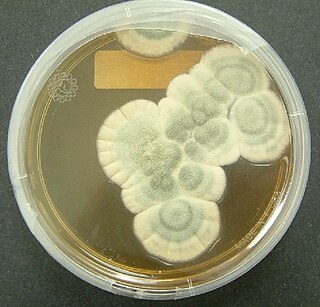
Penicillium is a genus of ascomycetous fungi that is part of the mycobiome of many species and is of major importance in the natural environment, in food spoilage, and in food and drug production.

Penicillium chrysogenum is a species of fungus in the genus Penicillium. It is common in temperate and subtropical regions and can be found on salted food products, but it is mostly found in indoor environments, especially in damp or water-damaged buildings. It has been recognised as a species complex that includes P. notatum, P. meleagrinum, and P. cyaneofulvum. Molecular phylogeny has established that Alexander Fleming's first discovered penicillin producing strain is of a distinct species, P. rubens, and not of P. notatum. It has rarely been reported as a cause of human disease. It is the source of several β-lactam antibiotics, most significantly penicillin. Other secondary metabolites of P. chrysogenum include roquefortine C, meleagrin, chrysogine, 6-MSA YWA1/melanin, andrastatin A, fungisporin, secalonic acids, sorbicillin, and PR-toxin.
Penicillium alfredii is a fungus species of the genus of Penicillium which is named after Alfred P. Sloan.
Penicillium citrinum is an anamorph, mesophilic fungus species of the genus of Penicillium which produces tanzawaic acid A-D, ACC, Mevastatin, Quinocitrinine A, Quinocitrinine B, and nephrotoxic citrinin. Penicillium citrinum is often found on moldy citrus fruits and occasionally it occurs in tropical spices and cereals. This Penicillium species also causes mortality for the mosquito Culex quinquefasciatus. Because of its mesophilic character, Penicillium citrinum occurs worldwide. The first statin (Mevastatin) was 1970 isolated from this species.
Penicillium confertum is an anamorph fungus species of the genus of Penicillium.
Penicillium coralligerum is a species of the genus of Penicillium. It is a marine species sometimes referred to as a deep-sea fungus and in some languages named the equivalent of "deep-sea mold".
Penicillium cryptum is a species of the genus of Penicillium.
Penicillium crystallinum is a species of the genus of Penicillium.
Penicillium decaturense is a species of the genus of Penicillium which was isolated from a fungus in North America. Penicillium decaturense produces citrinin, 15-Deoxyoxalicine B, decaturins A and decaturins A
Penicillium dierckxii is a species of the genus of Penicillium which produces citreoviridin and citrinin.
Penicillium dodgei is a species of the genus of Penicillium.
Penicillium dunedinense is a species of the genus of Penicillium which was isolated in Dunedin in New Zealand.
Penicillium ellipsoideosporum is a species of the genus of Penicillium which was isolated in China.
Penicillium formosanum is a species of the genus of Penicillium which produces patulin and asteltoxin.
Penicillium glaucoalbidum is a species of the genus of Penicillium.
Penicillium gracilentum is a species of the genus of Penicillium.
Penicillium hetheringtonii is a species of the genus of Penicillium which is named after A.C. Hetherington. This species was first isolated from beach soil in Land's End Garden in Treasure Island, Florida in the United States. Penicillium hetheringtonii produces citrinin and quinolactacin.
Penicillium inflatum is an anamorph species of the genus of Penicillium which produces sterigmatocystin. It is from the Cremei section.

Penicillium spinulosum is a non-branched, fast-growing fungus with a swelling at the terminal of the stipe (vesiculate) in the genus Penicillium. P. spinulosum is able to grow and reproduce in environment with low temperature and low water availability, and is known to be acidotolerant. P. spinulosum is ubiquitously distributed, and can often be isolated from soil. Each individual strain of P. spinulosum differs from others in their colony morphology, including colony texture, amount of sporulation and roughness of conidia and conidiophores.


